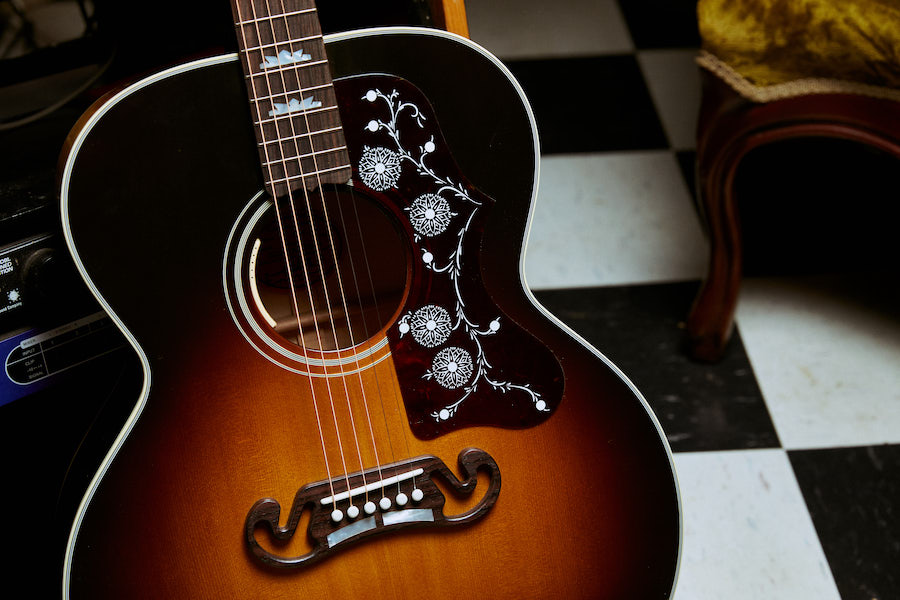

Even though that's years out it's bothersome. My SJ-200 is great (now) but took literally 2 years of slow-paced changes and warranty work to make it that way and i'm certain that it'll need a legitimate neck reset far sooner than my J45. I have a J45 and it's perfect, plays perfect too. I figure Gibson (and anyone else) probably has a neck jig they use that sets the the joint at a certain angle +/- a little, is it really as simple as that angle changing by a few degrees or is there some other reason that they wouldn't do it that way? I'm curious about this as it seems like such a trivial thing to do and I do see this thread topic come up pretty frequently. Is there any reason that the neck wouldn't (or shouldn't) be set that way? That would mean with the straight-edge test that the straight-edge might be >1/8" even above the top of the bridge and then the saddle set to accommodate that. I see what you're saying about the angle of the neck on the 4 ribbon bridge having to be higher. Talking about neck-set, be it "over-set" or not. Other than old instruments (like from the 1920's), I don't often see the quality of pearl that the Gibsons have. On a slightly tangential note, kudos to Gibson for the quality of their pearl. On a vintage guitar, though, the ribbons may necessitate a more expensive but also more definitive correction that can be delayed on a 2-ribbon bridge. So, I guess what I'm saying is that I recognize the problem but I don't consider it to be the ribbons. I think that, when they appear on an instrument, they have developed either over the normal course of extended time or in a shorter time frame if the guitar isn't maintained in the best conditions.

I don't think Gibsons leave the factory with those issues. But on any new guitar, if I had to consider shaving a bridge or slotting the pin holes to get acceptable action, I'd not be a happy camper, to put it mildly. On a used or vintage guitar, that's a different matter, of course (although, even then, I'd rather get the neck reset and have it be right). I'm not a fan of corrective actions that are stop-gap measures for a poorly set neck, be them bridge shaving or bridge slotting. Under these circumstances, the 4-ribbon bridge poses no problem whatsoever. I have very stable humidity control in my house and nary a problem with action, neck angle, etc. I've seen that at Guitar Center, for example, and almost wrote off getting a Gibson after seeing a couple of new guitars with saddles that had been shaved down to nothing to get the action playable. I think one problem that these instruments often encounter is top swelling in dealerships that over-humidify.
GIBSON J 200 ELITE TV
My SJ-200 TV has the 4 ribbons and the neck angle is exactly as it should be and the action is right on spec with plenty of saddle. Granted, the 4-ribbon bridge can make that a bigger problem but the source of trouble isn't the extra two ribbons it's the neck angle. In my opinion, any new guitar that needs to have its bridge slotted for good playing action has a problem it shouldn't have.
GIBSON J 200 ELITE INSTALL
I really dont want to mess about and install a non-original pickup and surely Gibson wouldn't let it leave the factory needing a neck reset? Would anyone contemplate that in this situation? Any advice greatfully received! I love the look and the tone of the guitar but I am worried that I am not going to be able to get it set up how I like it. He is suggesting that this could be soled by installing a piezo pad pickup instead. Also, when I plug it in I get poor treble response from ther under saddle pick up, again my luthier is suggesting that there is not enough pressure on the saddle due to the break angle on the upper strings. The saddle is lowish, but there is still a bit left that could be dropped (my Yamaha has a lower saddle but the bridge pins are closer to the saddle as it doesnt have the albalone inlay in between, increasing the break angle on that). It now measures about 3mm (1/8th of an inch) between the top of the fret and the bottom of the string on the low E at the 12th fret and a bit lower on the high E, which is a bit higher than I would like - I like a fairly low action. I have just had it at my luthier for a set up and while he has brought down the action a bit he was concerned about bringing it down any further due to the break angle on the top couple of strings. I bought a new Gibson SJ-200 custom elite about a month ago (it was made in March this year).


 0 kommentar(er)
0 kommentar(er)
